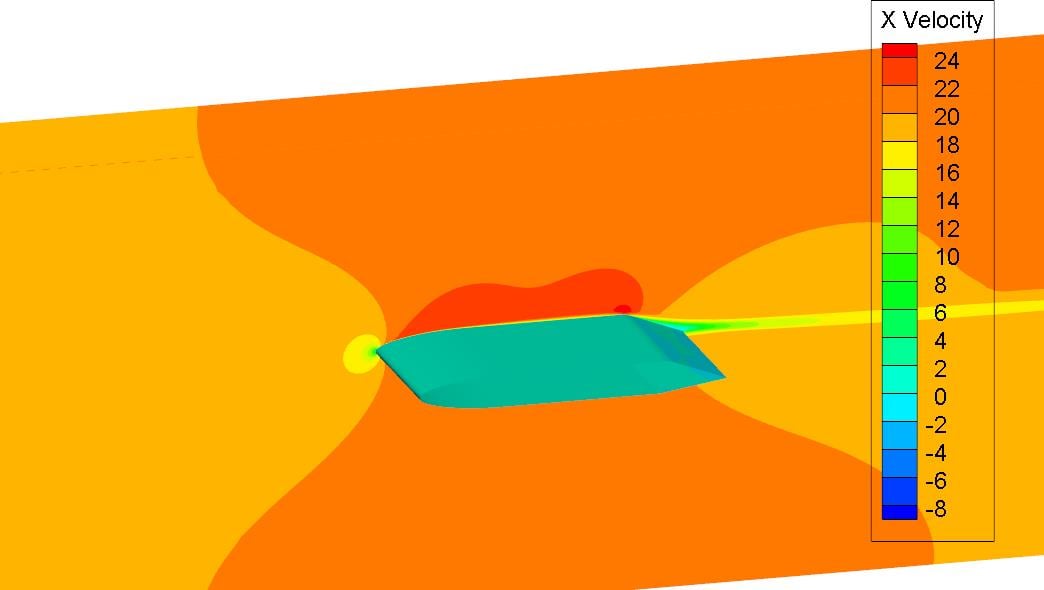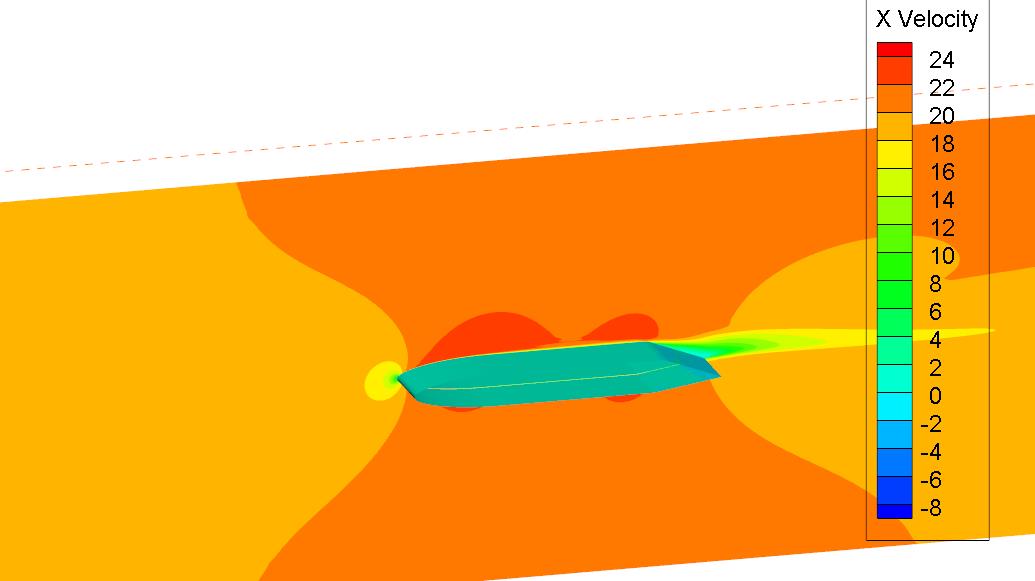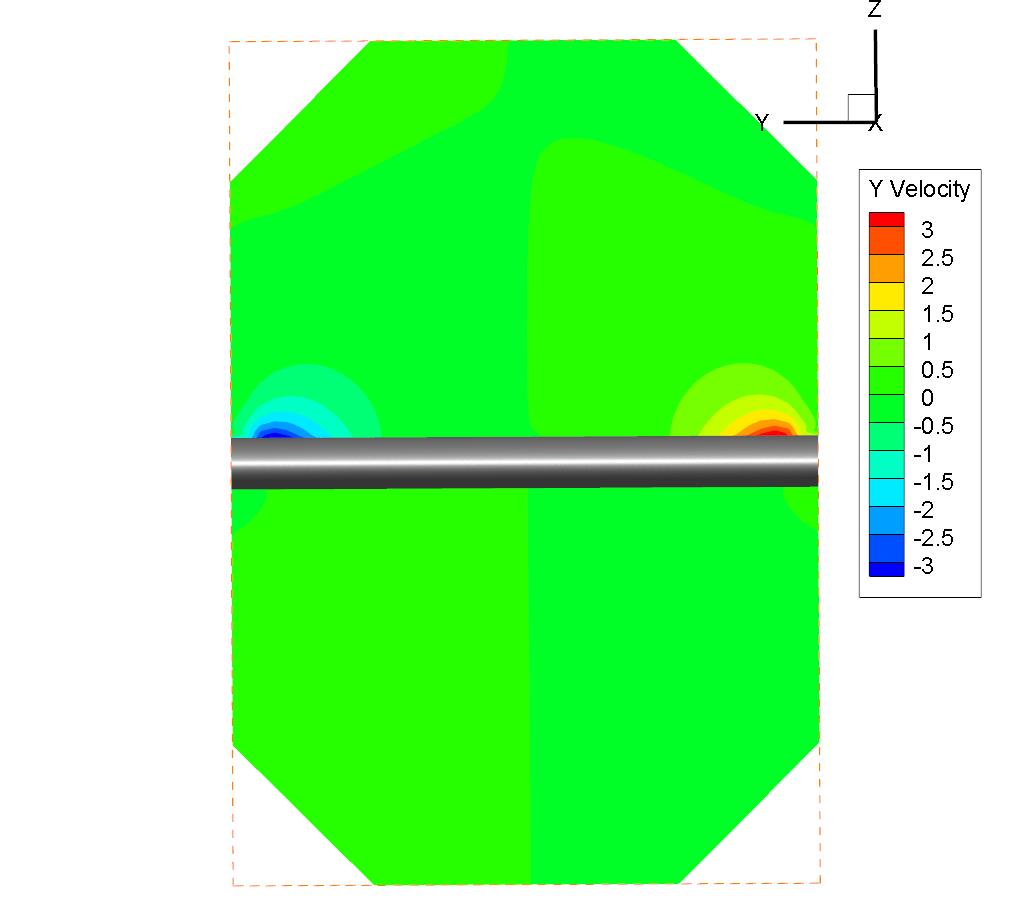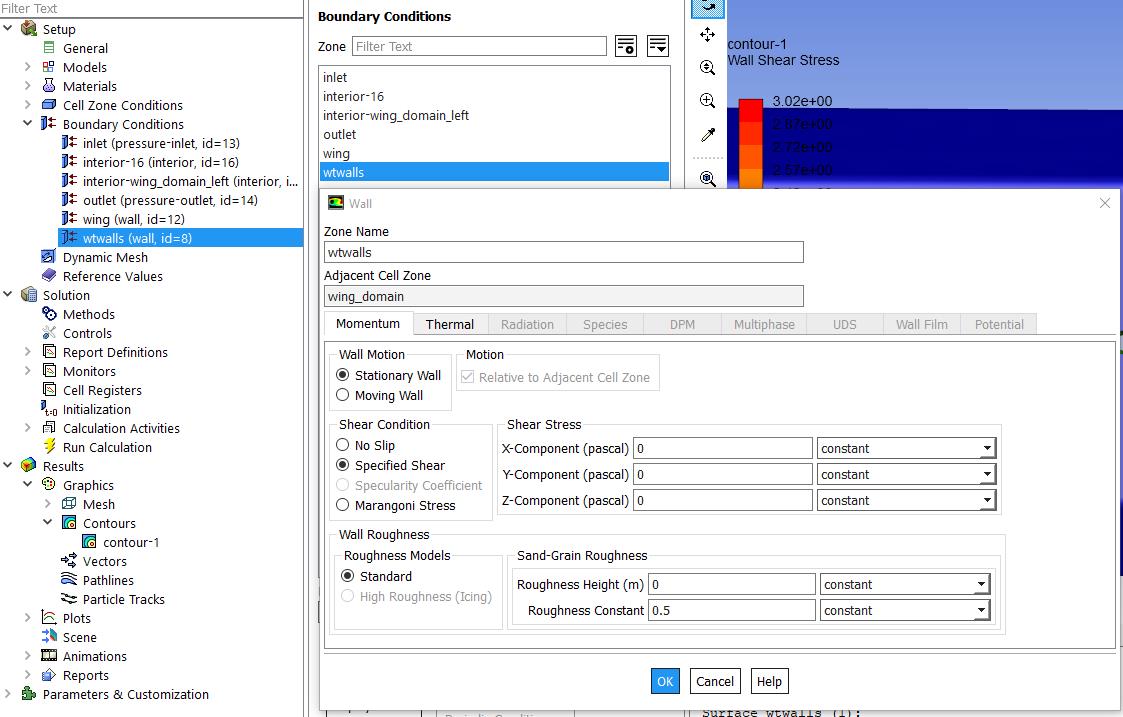-
-
July 30, 2019 at 12:17 pm
sbolk
SubscriberHello,
I want to simulate a wing in a wind tunnel test section. I am using the coupled pressure based solver in Fluent with a pseudo transient time step. The wind tunnel walls are set as free slip walls by specifying a zero shear force at the wall. I know from wind tunnel experiments that the flow does not separate over the flap. However, this is not what happens at the free slip walls in the CFD simulations. The flow stays attached over the flap away from the wall, but at the wall it separates, which makes no sense to me.
Does someone have an idea why this happens?
I checked the y+ value at the free slip walls, which I think should be zero. However, the second image shows that it is not zero, although the shear force at the wall really is zero.
-
July 30, 2019 at 2:54 pm
Rob
Forum ModeratorCan you plot a couple of planes showing the velocity at different wing positions parallel to the wall? Ie similar to the images above but at different y planes. Also check your mesh at the wing root.
-
July 30, 2019 at 3:30 pm
sbolk
SubscriberHere are slices parallel to the wall, at 0.5, 0.25, 0.1, and 0.01 span. It seems like the flow separation extends to around 10% of the span.
I don't see any major issues with the mesh. In spanwise direction, it is not so much refined since I shouldn't have a boundary layer at the free slip wall. The first cells at the root have a width of approximately 2.5% of the span. However due to the inflation layer of the wing they are quite thin and have a rather large aspect ratio in the order of 10^3. (Also, the mesh gets finer away from the wall, because later on I will have a propeller in the middle of the wing)
Thank you for your help.
-
July 31, 2019 at 10:56 am
Rob
Forum ModeratorCheck the y velocity component: given the angle I'd expect separation on all of the wing. Is the domain the same size as the wind tunnel?
-
July 31, 2019 at 11:55 am
sbolk
SubscriberThe y velocity is pretty much zero except close to the wall. These non-zero velocity components start from a chordwise perspective somewhere close to the flap hinge, so they are probably not caused by some sort of leading edge vortex.
The domain cross section has exactly the same dimensions as the cross section of the wind tunnel test section.
Flow separation or not, in general I would expect a 2D lift distribution, i.e. horizontal, over the span because the free slip wall shouldn't affect the pressure distribution on the wing. But instead I get a loss in lift at the intersection with the walls.
I can try using a symmetry boundary condition instead of the free shear walls, because for simulations of half of the wing with a symmetry boundary condition at the y=0.5 span I had no issues at the symmetry plane.
-
August 1, 2019 at 10:49 am
Rob
Forum ModeratorGiven it's symmetrical I think you really need to study the flow field, and talk to your supervisor: that's not something I can help with.
If you remesh with a more uniform size do you still see the effect?
-
August 1, 2019 at 10:58 am
sbolk
SubscriberI haven't tried a more uniform mesh yet, but with the symmetry boundary conditions instead of zero shear at the walls it works...
I know, symmetry isn't exactly the same as a free slip wall, but I think for my case it is acceptable.
Thank you anyways.
-
August 1, 2019 at 11:07 am
Rob
Forum ModeratorCan you post a screen grab of the wall panel for that surface?
-
August 1, 2019 at 11:23 am
-
August 1, 2019 at 12:12 pm
Rob
Forum ModeratorNo, for the boundary setting you used on the wall. I agree slip wall & symmetry should behave the same and want to check it's a slip wall!
-
August 1, 2019 at 12:19 pm
-
August 1, 2019 at 12:25 pm
Rob
Forum ModeratorThat looks right. Assuming you converged the cases can you ask your supervisor or University ANSYS contact to raise a ticket? It's probably something simple but not something I can diagnose via the Community.
-
August 1, 2019 at 1:35 pm
sbolk
SubscriberI will bring it up at my next meeting.
I assume that it converged. I ran it for 2000 iterations and monitored the lift and drag coefficients which both found steady values. However, the lift coefficient starts oscillating in the end. Due to the peculiar shape of the wing, the lift and drag is naturally quite low and therefore also the change in their coefficients in an absolute sense. After 2000 iterations the iterative error in the lift coefficient is less than 0.1%, the continuity and k residuals dropped by 3 orders of magnitude, the residuals for the velocity components and omega dropped by 6 orders of magnitude and the energy residual by 8 orders. For a structured mesh these residuals aren't really low which probably means that I should improve my mesh. However, it would surprise me if this is the cause for the strange behaviour at the wall.
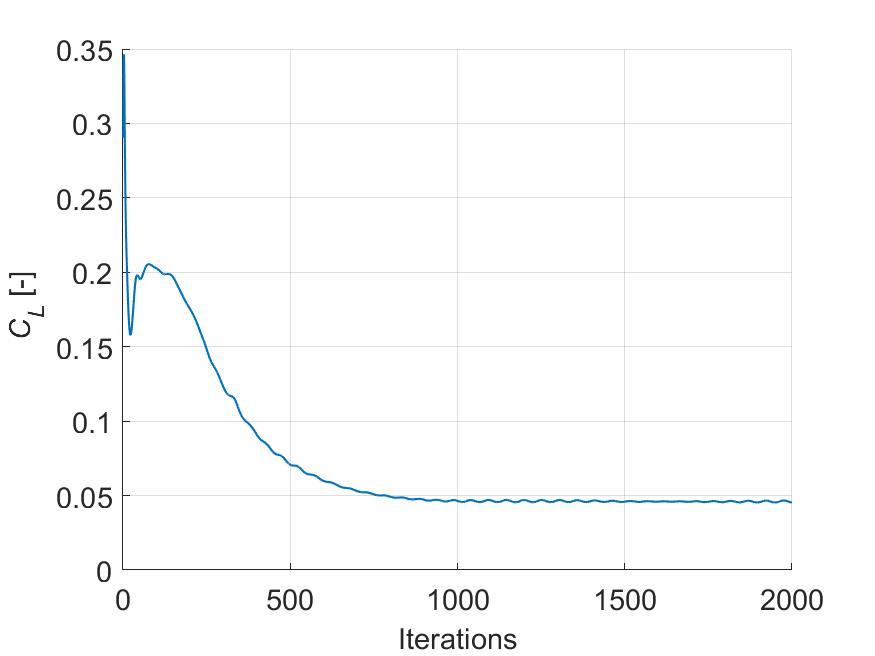
-
August 1, 2019 at 4:18 pm
Rob
Forum ModeratorThe slight wobble on the curve suggests a transient effect in the result. Does the residual plot look flat but with small amplitude high frequency noise? Stick a monitor point near the root, and approximately at the end of the separation zone then monitor pressure with iteration.
-
August 2, 2019 at 10:29 am
sbolk
SubscriberYes the residuals look like you described. I don't know about "high" frequency though. The fluctuations look pretty much the same in amplitude and frequency like the wobbles in the Cl plot.
I remember reading in the Fluent user's guide that a too small time step can cause numerical instabilities at free slip walls. Unfortunately I can't find it anymore. I guess this is what is happening here. The pseudo-transient time step was 0.001 s which corresponds to about 2% chord length traveled per time step at my 20 m/s. I can try again with a larger time step and monitor the pressure like you described. But I remember from previous simulations that I often got divergence for larger time steps.
-
August 2, 2019 at 10:54 am
Rob
Forum ModeratorThe pseudo step is a time scale factor, not a true time step: if you're using values down at 0.001 then you're really under relaxing the solution. That could imply the whole model is transient.
-
August 6, 2019 at 10:21 am
sbolk
SubscriberWith a larger pseudo time step of 0.08 (largest one possible without divergence in the beginning) the oscillations are clearly visible in the lift coefficient, and in the pressure at a point close to the separation area. It seems like the flow over the flap alternates between being attached and separated. But only close to the wall, not in the middle of the wing.
Is the time step still too small? Should I try it with the CFL condition instead?
I can see now what is going on at the wall. However, I still don't understand why it is happening. And moreover, why this only happens with the free slip wall and not with a no slip wall. Any thoughts?
Thank you
-
August 6, 2019 at 12:50 pm
Rob
Forum ModeratorYou're not using a time step as it's a steady solver: you're using a factor. Just to be pedantic. Try running with the transient solver and see what happens.
-
August 6, 2019 at 2:35 pm
sbolk
SubscriberIn the transient case I get reversed flow warnings at the pressure inlet, but when I stop it to check the velocity at the inlet there is no reversed flow...
I started it from the previous steady result. At least at the wall the flow seems to not separate anymore.
-
August 7, 2019 at 2:39 pm
Rob
Forum ModeratorDisplay velocity vector contour on the outlet with node values off and clip -20 to 0. Then have a look. It may be a tiny area triggering the warning.
How long (what time does the solver show) have you run?
-
August 8, 2019 at 9:47 am
sbolk
SubscriberEven with node values off and clipped to the negative range, no reversed flow cells are shown, although the warning says that there would be reversed flow in over 1000 cells, which is about 25% of the total number of cells at the inlet.
This already happens within the first time step after 5 iterations.
-
August 8, 2019 at 10:01 am
Rob
Forum ModeratorYou will need to run more time steps. It's also possible it's a false warning if the near wall cell velocity is zero: it's possible Fluent is seeing -0.00000000000000000000000001m/s due to gradient rounding.
-
August 9, 2019 at 8:44 am
sbolk
SubscriberYou were right, after some time steps the warning disappeared and the the solution converged to a more realistic result without flow separation at the wall.
I will mark this as solved, because switching to the transient solver seems to do the trick.
Thank you very much for your help.
-
- The topic ‘Flow separation at free slip wall’ is closed to new replies.


- air flow in and out of computer case
- Varying Bond model parameters to mimic soil particle cohesion/stiction
- Eroded Mass due to Erosion of Soil Particles by Fluids
- I am doing a corona simulation. But particles are not spreading.
- Centrifugal Fan Analysis for Determination of Characteristic Curve
- Guidance needed for Conjugate Heat Transfer Analysis for a 3s3p Li-ion Battery
- Issue to compile a UDF in ANSYS Fluent
- JACOBI Convergence Issue in ANSYS AQWA
- affinity not set
- Resuming SAG Mill Simulation with New Particle Batch in Rocky

-
4047
-
1467
-
1308
-
1156
-
1021

© 2025 Copyright ANSYS, Inc. All rights reserved.




